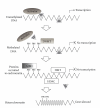Deciphering squamous cell carcinoma using multidimensional genomic approaches
- PMID: 21234096
- PMCID: PMC3017908
- DOI: 10.1155/2011/541405
Deciphering squamous cell carcinoma using multidimensional genomic approaches
Abstract
Squamous cell carcinomas (SqCCs) arise in a wide range of tissues including skin, lung, and oral mucosa. Although all SqCCs are epithelial in origin and share common nomenclature, these cancers differ greatly with respect to incidence, prognosis, and treatment. Current knowledge of genetic similarities and differences between SqCCs is insufficient to describe the biology of these cancers, which arise from diverse tissue origins. In this paper we provide a general overview of whole genome approaches for gene and pathway discovery and highlight the advancement of integrative genomics as a state-of-the-art technology in the study of SqCC genetics.
Figures







Similar articles
-
Title- Genomic landscape of squamous cell carcinoma- Different genetic pathways culminating in a common phenotype.Cancer Treat Res Commun. 2020;25:100238. doi: 10.1016/j.ctarc.2020.100238. Epub 2020 Nov 26. Cancer Treat Res Commun. 2020. PMID: 33260028
-
Comprehensive analysis of oncogenic mutations in lung squamous cell carcinoma with minor glandular component.Chest. 2014 Mar 1;145(3):473-479. doi: 10.1378/chest.12-2679. Chest. 2014. PMID: 24158231
-
Primary esophageal small cell carcinoma with concomitant invasive squamous cell carcinoma or carcinoma in situ.Hum Pathol. 2003 Nov;34(11):1108-15. doi: 10.1053/j.humpath.2003.07.010. Hum Pathol. 2003. PMID: 14652811
-
New developments in the treatment of squamous cell lung cancer.Curr Opin Oncol. 2014 Mar;26(2):152-8. doi: 10.1097/CCO.0000000000000049. Curr Opin Oncol. 2014. PMID: 24441504 Review.
-
Role of afatinib in the treatment of advanced lung squamous cell carcinoma.Clin Pharmacol. 2017 Nov 27;9:147-157. doi: 10.2147/CPAA.S112715. eCollection 2017. Clin Pharmacol. 2017. PMID: 29225480 Free PMC article. Review.
Cited by
-
Non-coding RNAs in the development and pathogenesis of eukaryotic microbes.Appl Microbiol Biotechnol. 2013 Sep;97(18):7989-97. doi: 10.1007/s00253-013-5160-y. Epub 2013 Aug 16. Appl Microbiol Biotechnol. 2013. PMID: 23948725 Free PMC article.
-
Whole transcriptome sequencing identifies tumor-specific mutations in human oral squamous cell carcinoma.BMC Med Genomics. 2013 Sep 4;6:28. doi: 10.1186/1755-8794-6-28. BMC Med Genomics. 2013. PMID: 24007313 Free PMC article.
-
The Role of TGFβ Signaling in Squamous Cell Cancer: Lessons from Mouse Models.J Skin Cancer. 2012;2012:249063. doi: 10.1155/2012/249063. Epub 2012 Dec 26. J Skin Cancer. 2012. PMID: 23326666 Free PMC article.
-
Wnt Signaling Pathways in Keratinocyte Carcinomas.Cancers (Basel). 2019 Aug 21;11(9):1216. doi: 10.3390/cancers11091216. Cancers (Basel). 2019. PMID: 31438551 Free PMC article. Review.
-
USP28: Oncogene or Tumor Suppressor? A Unifying Paradigm for Squamous Cell Carcinoma.Cells. 2021 Oct 4;10(10):2652. doi: 10.3390/cells10102652. Cells. 2021. PMID: 34685632 Free PMC article. Review.
References
-
- Hanahan D, Weinberg RA. The hallmarks of cancer. Cell. 2000;100(1):57–70. - PubMed
-
- de Klein A. Oncogene activation by chromosomal rearrangement in chronic myelocytic leukemia. Mutation Research. 1987;186(2):161–172. - PubMed
-
- Haluska FG, Tsujimoto Y, Croce CM. Oncogene activation by chromosome translocation in human malignancy. Annual Review of Genetics. 1987;21:321–345. - PubMed
-
- Dessars B, de Raeve LE, Housni HE, et al. Chromosomal translocations as a mechanism of BRAF activation in two cases of large congenital melanocytic nevi. Journal of Investigative Dermatology. 2007;127(6):1468–1470. - PubMed
Grants and funding
LinkOut - more resources
Full Text Sources

